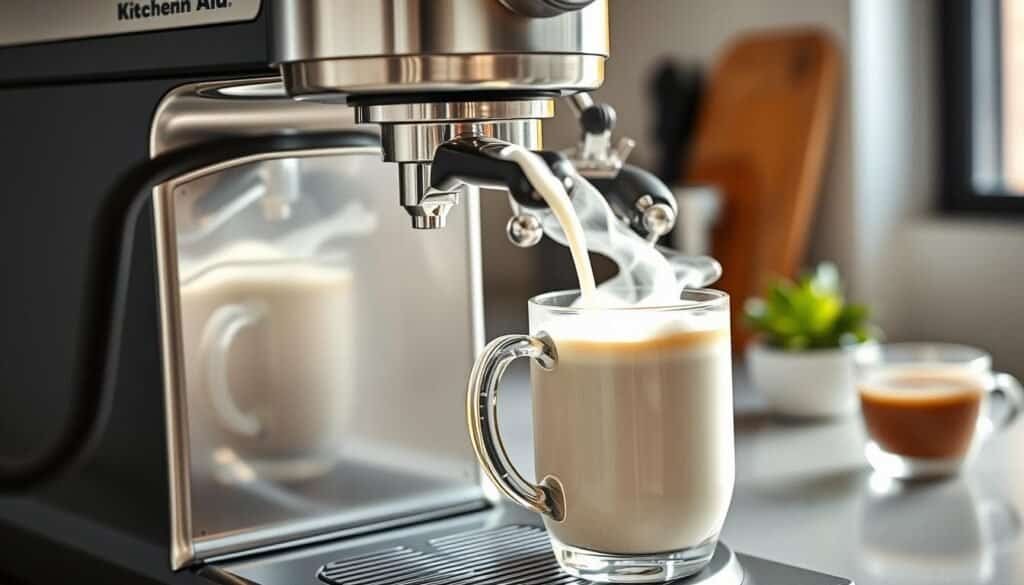Are you having trouble making perfect milk froth with your KitchenAid espresso machine? You’re not alone. Many coffee fans struggle with frothing milk, but with the right tips, you can get it right.
This guide will teach you all about frothing milk with your KitchenAid. You’ll learn about your machine’s features and advanced frothing techniques. Whether you’re new to coffee or a seasoned barista, this guide will help you improve your coffee skills. You’ll be able to make perfect milk froth with your KitchenAid espresso machine.
In This Article
Understanding Your KitchenAid Espresso Machine’s Frothing Capabilities
To get the most out of your KitchenAid espresso machine, it’s key to know its frothing abilities. This knowledge helps you use your machine better and make perfect milk froth. The kitchenaid espresso machine frothing guide is a great place to start. It gives a detailed look at the machine’s features and how to get the best results.
Frothing milk right is all about using the right techniques. Learning to froth milk with KitchenAid takes practice, but with the right help, you can get it right. The frothing techniques for kitchenaid espresso machine help you make different milk textures, from silky microfoam to thick foam.
- Steam wand components, which are key for perfect froth
- Power and pressure specs, which affect the machine’s frothing ability
- Frothing mechanism, which makes the milk smooth and creamy
Knowing how these parts work together lets you use your KitchenAid espresso machine to its fullest. With practice and patience, you’ll get better at frothing milk. Soon, you’ll be making delicious coffee drinks with ease.
Essential Equipment for Perfect Milk Frothing
To froth milk perfectly with KitchenAid, you need the right tools. You’ll need a steam wand, a milk frothing pitcher, and a thermometer. These help you get the perfect milk texture and temperature for your coffee.
When picking out equipment for your KitchenAid espresso machine, keep these frothing milk tips KitchenAid machine owners love in mind:
- A high-quality steam wand for consistent steam flow
- A milk frothing pitcher with a built-in thermometer for temperature control
- A thermometer to check if the milk is at the right temperature
Investing in the right gear and following these frothing milk tips KitchenAid machine owners suggest will help you froth milk perfectly. Always follow your KitchenAid model’s guidelines for the best results.
With the right tools and a bit of practice, you can froth milk perfectly with KitchenAid. Try different milks and frothing methods to find your favorite.
Choosing the Right Milk for Frothing
Choosing the right milk is key to frothing milk like a barista with your KitchenAid milk frother for espresso. The fat content, protein structure, and temperature of the milk matter a lot. They all impact the quality of your froth.
Here are some factors to consider when choosing the right milk for frothing:
- Whole milk vs. low-fat options: Whole milk has more fat, making the froth richer and creamier. Low-fat milks can make a lighter, airier froth.
- Plant-based alternatives: Plant-based milks like almond or soy milk can be used instead of dairy. But, you might need to tweak your frothing method.
- Temperature considerations: The best temperature for frothing milk is between 140°F and 160°F. This temperature helps get the perfect balance of foam and liquid.
Whole Milk vs. Low-Fat Options
Whole milk is the classic choice for frothing because of its higher fat content. This makes the froth richer and creamier. But, if you prefer a lighter froth, low-fat options are a good alternative.
Plant-Based Alternatives
Plant-based milks like almond or soy milk can be used as substitutes for dairy. But, they might not froth as well because of their lower fat content. You might need to adjust your frothing technique.
Temperature Considerations
The ideal temperature for frothing milk is between 140°F and 160°F. This temperature is perfect for getting the right balance of foam and liquid. If the milk is too hot, it can burn or become too frothy. If it’s too cold, it won’t froth well.
Preparing Your KitchenAid Machine for Milk Frothing
To froth milk with KitchenAid espresso machine, you must prepare your machine. Start by purging the steam wand. This removes water and debris, preventing blockages and contamination.
Then, set the temperature right for frothing milk with KitchenAid espresso maker. The ideal range is 140°F to 160°F. Adjust this using your machine’s control panel. Remember, the milk type also matters, so pick one that froths well.
Here are the main steps to get your KitchenAid ready for frothing:
- Purge the steam wand to remove excess water or debris
- Set the right temperature for frothing milk (between 140°F and 160°F)
- Choose a suitable milk for frothing
By following these steps, your KitchenAid will be ready for frothing milk with KitchenAid espresso machine. This ensures you get the perfect froth for tasty coffee drinks.
How to Froth Milk with KitchenAid Espresso Machine: Step-by-Step Process
To froth milk for latte with kitchenaid machine, you need to know the steps. The kitchenaid espresso machine frothing guide will show you how to get it right.
Before starting, check that you have the right tools and the milk is the right temperature. The best temperature for frothing milk is between 140°F and 160°F.
Initial Position and Angles
The first thing is to set the steam wand correctly. It should be just below the milk’s surface. The pitcher should be at an angle to swirl the milk.
Creating the Perfect Swirl
To make the perfect swirl, move the pitcher in circles while steam is added. This mixes air and makes the froth smooth and creamy.
By following these steps and using the kitchenaid espresso machine frothing guide, you can froth milk for latte with kitchenaid machine like a pro. Remember, practice makes perfect. It might take a few tries to get it just right.
Creating Different Milk Textures for Various Drinks
To froth milk perfectly with kitchenaid espresso machine, you need to know about different milk textures. Each drink, like a latte, cappuccino, or macchiato, needs its own texture. The right texture can change the whole drink.
With frothing techniques for kitchenaid espresso machine, you can make various milk textures. Here are a few examples:
Silky Microfoam for Lattes
To make silky microfoam, adjust the steam pressure and temperature. This creates a smooth, velvety texture. It’s ideal for lattes, adding a luxurious feel.
Thick Foam for Cappuccinos
For cappuccinos, you want thick, robust foam. Increase the steam pressure and temperature. This makes a rich, creamy foam perfect for cappuccinos.
Light Froth for Macchiatos
Macchiatos need light, delicate froth. Use lower steam pressure and cooler temperature. This creates a light, airy froth that sweetens the drink.
Mastering these milk textures lets you make a variety of tasty drinks with your KitchenAid espresso machine. Whether you’re a coffee lover or just starting, frothing techniques for kitchenaid espresso machine can elevate your coffee experience.
Common Frothing Mistakes to Avoid
Using a kitchenaid milk frother for espresso can lead to mistakes that spoil the froth. To froth milk like a barista with kitchenaid, knowing these errors is key. You must avoid them to get the best froth.
One big mistake is over-aerating the milk, making it too foamy or thin. To fix this, tweak the steam pressure and keep an eye on the milk’s temperature. Also, picking the wrong milk can mess up the frothing. So, always choose a milk that froths well.
To get the perfect froth, using your kitchenaid milk frother for espresso right is crucial. This means adjusting the steam wand, watching the temperature, and picking the right milk. By steering clear of these common mistakes and following these tips, you can froth milk like a barista with kitchenaid. You’ll make tasty espresso drinks at home.
- Adjust the steam pressure to avoid over-aerating the milk
- Monitor the milk’s temperature to achieve the perfect froth
- Choose a milk that is suitable for frothing
By sticking to these tips and dodging common frothing errors, you can become a pro barista. You’ll whip up amazing espresso drinks with your kitchenaid milk frother for espresso.
Maintaining Your Steam Wand for Optimal Performance
To keep your KitchenAid espresso machine frothing milk well, you need to take care of the steam wand. A simple daily cleaning and occasional deep cleaning can stop calcium buildup. This is key if you froth milk often, as it makes your machine last longer.
Here are some tips to help you maintain your steam wand:
- Daily cleaning: After each use, wipe the steam wand with a damp cloth to remove any milk residue.
- Deep cleaning: Every week, soak the steam wand in a mixture of water and vinegar to remove any built-up calcium deposits.
- Preventing calcium buildup: Use a water filter to reduce mineral deposits in the water, and descale your machine regularly to prevent calcium buildup.
By following these simple steps, you can keep your steam wand in good condition. This way, you can froth milk with your KitchenAid espresso maker easily. Always check your machine’s user manual for specific maintenance instructions.
Advanced Frothing Techniques for Latte Art
To improve your milk frothing skills, try advanced techniques for latte art with your KitchenAid espresso machine. With practice, you can make beautiful patterns and designs. The secret is to know how to froth milk and use the steam wand for textures and patterns.
As you get better, try different pouring methods. Free pouring, etching, and stenciling are all fun to try. Free pouring makes a layered look by pouring milk over espresso. Etching needs patience and a steady hand to draw designs with the steam wand.
Basic Pouring Techniques
- Free pouring: This technique involves pouring the steamed milk directly onto the espresso, creating a layered effect.
- Etching: This technique requires a steady hand and a bit of patience, as you’ll be using the steam wand to create intricate designs on the surface of the milk.
- Stenciling: This technique involves using a stencil to create intricate designs and patterns on the surface of the milk.
Follow the KitchenAid espresso machine frothing guide to make stunning latte art. Practice frothing milk to get better. Always try new things and have fun, as latte art keeps getting more creative.
Troubleshooting Common Frothing Issues
Using your KitchenAid espresso machine to froth milk can sometimes lead to issues. These problems can affect the quality of your frothed milk. We’ll give you some tips and solutions to help you overcome these problems. By learning frothing techniques for KitchenAid espresso machine, you can froth milk perfectly with KitchenAid and make tasty coffee drinks.
Common issues include large bubbles, temperature control problems, or steam pressure issues. These problems can be annoying, but they can be fixed with the right techniques and adjustments. Let’s look at some common problems and their solutions:
- Large bubbles: This can happen if the steam wand is not in the right spot or if the milk is too cold. To solve this, adjust the steam wand and make sure the milk is at the right temperature.
- Temperature control issues: This might be due to a broken thermometer or wrong machine settings. To fix it, check the thermometer and make sure the machine settings are correct.
- Steam pressure problems: This could be because of a clogged steam wand or not keeping the machine well-maintained. To fix it, clean the steam wand and keep the machine in good shape.
By following these tips and mastering frothing techniques for KitchenAid espresso machine, you can froth milk perfectly with KitchenAid. This will help you make delicious coffee drinks easily. Always check your machine’s user manual for specific troubleshooting and maintenance advice.
Professional Tips for Consistent Results
To get consistent results with your kitchenaid milk frother for espresso, follow some key tips. You can froth milk like a barista with kitchenaid by tweaking the steam pressure, temperature, and frothing time. Here are some important things to keep in mind:
When frothing milk with your kitchenaid, aim for a temperature between 140°F and 160°F. Adjust the steam pressure to get a smooth, silky texture. To froth milk like a barista with kitchenaid, try these steps:
- Start with cold milk for frothing
- Purge the steam wand before frothing to remove excess water
- Submerge the steam wand just below the milk’s surface to create a whirlpool
By following these tips, you can make perfect milk froth every time with your kitchenaid milk frother for espresso. Experiment with different steam pressures and temperatures to find the perfect mix for your coffee. With practice, you’ll be able to froth milk like a barista with kitchenaid and enjoy top-notch espresso drinks at home.
Conclusion: Mastering Milk Frothing with Your KitchenAid
Frothing milk with your KitchenAid espresso machine is a skill that needs practice. But with the right techniques, you can make rich, velvety milk froth. Start with high-quality milk, adjust the steam wand, and watch the temperature to get it just right.
This guide will help you become a milk frothing expert. You’ll impress your family and friends with your latte art and cappuccinos. Don’t be afraid to try new things and find what works best for you and your KitchenAid machine.
With dedication, you can make your coffee experience better. Enjoy café-quality drinks at home. So, grab your KitchenAid, put on your apron, and start frothing milk like a pro!
FAQ
How do I froth milk with KitchenAid espresso machine?
To froth milk with your KitchenAid espresso machine, follow these steps:
- Prepare your machine by purging the steam wand and setting the right temperature and steam pressure.
- Fill a milk frothing pitcher with the desired amount of milk, holding the pitcher at a slight angle.
- Slowly lower the steam wand into the milk, keeping the tip just below the surface.
- Turn on the steam and create a swirling motion to incorporate air and produce a smooth, microfoam texture.
- Monitor the temperature and stop steaming when the milk reaches the desired temperature.
What type of milk works best for frothing?
Whole milk is the best for frothing because it has more fat. This makes the froth rich and creamy. Low-fat or non-fat milk can also work, but the froth might be less dense. Plant-based milks like almond or oat milk can be tricky, but with the right technique, you can still get good results.
How do I clean and maintain my KitchenAid espresso machine’s steam wand?
To keep your steam wand in top condition, follow these maintenance tips:
- Perform a daily cleaning routine by wiping down the steam wand with a damp cloth after each use.
- Periodically, do a deep cleaning by running a steam wand cleaning solution through the wand to remove any built-up residue.
- Prevent calcium buildup by backflushing your machine regularly and descaling it as recommended by the manufacturer.
How can I create different milk textures for various drinks?
To create different milk textures, adjust the steam pressure, temperature, and frothing time:
- For a silky microfoam perfect for lattes, aim for a smooth, velvety texture with minimal visible bubbles.
- For a thick, creamy foam suitable for cappuccinos, increase the steam pressure and frothing time to incorporate more air.
- For a light, airy froth ideal for macchiatos, use a lower steam pressure and shorter frothing time to create a delicate, aerated milk.
What are some common frothing mistakes to avoid?
Some common frothing mistakes to avoid include:
- Over-aerating the milk, leading to large, uneven bubbles
- Using the wrong type of milk, such as low-fat or non-fat, which can be more difficult to froth
- Not adjusting the steam pressure correctly, resulting in either too much or too little foam
- Allowing the milk to get too hot, which can cause the proteins to break down and produce a grainy texture
How can I create latte art with my KitchenAid espresso machine?
To create latte art with your KitchenAid espresso machine, follow these steps:
- Master the basic pouring techniques, such as holding the pitcher at the right angle and controlling the flow of the milk.
- Experiment with different patterns and designs, such as hearts, rosettes, or leaves, by adjusting the speed and direction of your pour.
- Practice, practice, practice! Latte art takes time and patience to perfect, but with the right techniques and a bit of creativity, you can create beautiful designs.
How do I troubleshoot common frothing issues?
Here are some solutions to common frothing issues:
- Large bubbles: Adjust the steam pressure and frothing technique to incorporate more air more evenly.
- Temperature control issues: Make sure to use a thermometer and monitor the milk temperature closely, stopping the steaming process when the milk reaches the desired temperature.
- Steam pressure problems: Check your machine’s specifications and make sure the steam pressure is set correctly. Descale your machine if necessary to ensure optimal performance.
What are some professional tips for consistent milk frothing results?
Here are some professional tips for consistent milk frothing results:
- Experiment with different steam pressure and temperature settings to find the optimal combination for your machine and the type of milk you’re using.
- Pay close attention to the sound and appearance of the milk as it’s frothing, and adjust your technique accordingly.
- Practice, practice, practice! The more you froth milk, the more comfortable and confident you’ll become with the process.
- Maintain your machine regularly to ensure it’s performing at its best and to prevent issues like steam wand clogs or calcium buildup.



